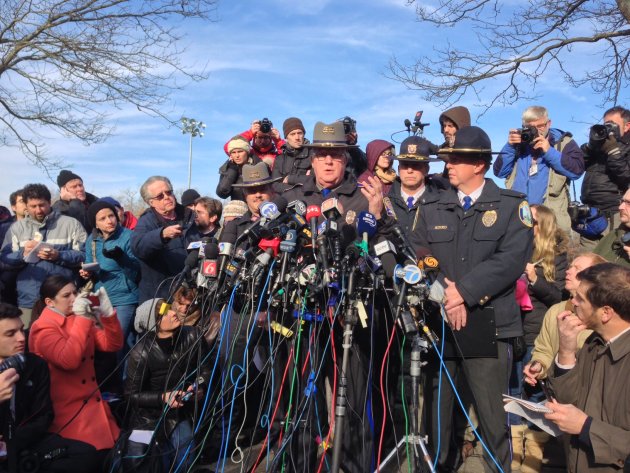NEW YORK (AP) — The scope and senselessness of the Newtown, Conn., school shooting challenged television journalists' ability to do much more than lend, or impose, their presence on the scene.
Pressed with the awful urgency of the story, TV, along with other media, fell prey to reporting "facts" that were often in conflict or wrong.
How many people were killed? Which Lanza brother was the shooter: Adam or Ryan? Was their mother, who was among the slain, a teacher at the school?
Like the rest of the news media, television outlets were faced with intense competitive pressures and an audience ravenous for details in an age when the best-available information was seldom as reliable as the networks' high-tech delivery systems.
Here was the normal gestation of an unfolding story. But with wall-to-wall cable coverage and second-by-second Twitter postings, the process of updating and correcting it was visible to every onlooker. And as facts were gathered by authorities, then shared with reporters (often on background), a seemingly higher-than-usual number of points failed to pan out:
— The number of dead was initially reported as anywhere from the high teens to nearly 30. The final count was established Friday afternoon: 20 children and six adults, as well as Lanza's mother and the shooter himself.
— For hours on Friday, the shooter was identified as Ryan Lanza, with his age alternatively reported as 24 or 20. The confusion seemed partly explainable when it was determined that 20-year-old Adam Lanza, the shooter who had then killed himself, was carrying identification belonging to his 24-year-old brother.
This case of mistaken identity was painfully reminiscent of the Atlanta Olympics bombing case in 1996, when authorities fingered an innocent man, and the news media ran with it, destroying his life. Such damage was averted in Ryan Lanza's case largely by his public protestations on social media, repeatedly declaring "It wasn't me."
— Initial reports differed as to whether Lanza's mother, Nancy, was shot at the school, where she was said to be a teacher, or at the home she shared with Adam Lanza. By Friday afternoon, it was determined that she had been shot at their home.
Then doubts arose about whether Nancy Lanza had any link to Sandy Hook Elementary. At least one parent said she was a substitute teacher, but by early Saturday, an official said investigators had been unable to establish any connection with the school.
That seemed to make the massacre even more confusing. Early on, the attack was said to have taken place in her own classroom and was interpreted by more than one on-air analyst as possibly a way for Adam Lanza to strike back at children with whom he felt rivalry for his mother's affection.
— Lanza's weapons were listed as two pistols (a Glock and a Sig Sauer) as well as a .223-caliber Bushmaster rifle, but whether that rifle was used in the school or left in the trunk of Lanza's car remained unclear.
— There were numerous versions of what Lanza was wearing, including camouflage attire and black paramilitary garb.
With so many unanswered questions, TV correspondents were left to set the scene and to convey the impact in words that continually failed them.
However apt, the phrase "parents' worst nightmare" became an instant cliche.
And the word "unimaginable" was used countless times. But "imagine" was exactly what the horrified audience was helpless not to do.
The screen was mostly occupied by grim or tearful faces, sparing everybody besides law enforcement officials the most chilling sight: the death scene in the school, where — as viewers were reminded over and over — the bodies remained while evidence was gathered. But who could keep from imagining it?
Ironically, perhaps the most powerful video came from 300 miles away, in Washington, where President Barack Obama delivered brief remarks about the tragedy. His somber face, the flat tone of his voice, the tears he daubed from his eyes, and his long, tormented pauses said as much as his heartfelt words. He seemed to speak for everyone who heard them.
But TV had hours to fill.
Children from the school were interviewed. It was a questionable decision for which the networks took heat from media critics and viewers alike. But the decision lay more in the hands of the willing parents (who were present), and there was value in hearing what these tiny witnesses had to say.
"We had to lock our doors so the animal couldn't get in," said one little boy, his words painting a haunting picture.
In the absence of much hard information, speculation was a regular fallback. Correspondents and other "experts" persisted in diagnosing the shooter, a man none of them had ever met or even heard of until hours earlier.
CNN's "Piers Morgan Tonight" scored an interview with a former classmate of Lanza's — with an emphasis on "former."
"I really only knew him closely when we were very, very young, in elementary school together," she said.
Determined to unlock Lanza's personality, Morgan asked the woman if she "could have ever predicted that he would one day flip and do something as monstrous as this?"
"I don't know if I could have predicted it," she replied, struggling to give Morgan what he wanted. "I mean, there was something 'off' about him."
The larger implications of the tragedy were broached throughout the coverage — not least by Obama.
"We're going to have to come together and take meaningful action to prevent more tragedies like this, regardless of the politics," he said, which may have gladdened proponents of stricter gun laws.
But CBS correspondent Nancy Cordes noted, "There's often an assumption that after a horrific event like this, it will spark a fierce debate on the issue. But in recent years, that hasn't been the case."
Appearing on "The O'Reilly Factor" Friday night, Fox News correspondent Geraldo Rivera voiced his own solution.
"I want an armed cop at every school," he said.











